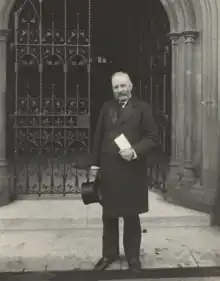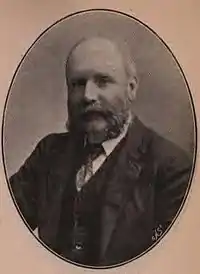Jasper More (Liberal politician)
Robert Jasper More (30 October 1836 – 25 November 1903) was an English landowner, barrister and Liberal politician who sat in the House of Commons in two periods between 1865 and 1903.

Life
More was the son of the Rev. Thomas Frederick More, J.P., of Linley Hall, Shropshire, and his wife Harriet Mary More, daughter of Thomas More of Larden Hall, Much Wenlock. He was educated at Balliol College, Oxford, where he graduated as BA in 1860 and MA and BCL in 1862. He was called to the bar at Lincoln's Inn in 1863.[1][2]
More was elected as Member of Parliament for Shropshire South in 1865[3] but lost the seat in 1868. In 1876 he made a tour of the Balkans after the April Uprising with Lady Strangford[4] of which he subsequently published an account.[5]
More was a J.P. and Deputy Lieutenant for Shropshire and High Sheriff of Shropshire in 1881. He was also a J.P. for Montgomeryshire.[1]

In 1885, More stood at Ludlow and won the seat which he retained until his death in 1903 at the age of 67. In parliament he supported Lord Winchilsea's National Agricultural Union, opposed to the National Agricultural Labourers' Union.[6]
Lead mining
Mining was one of More's interests.[7] His father, who died in 1869, was rector of Shelve, near Worthen in south-west Shropshire.[8] The Foxhill lead mine at Shelve Hill was active in the 19th century,[9] in an area where there had been Roman mines.[10] The Rev. More leased mineral rights to the Gravels Lead Mining Co. and the Broomlow Mining Co.[11] Thomas Wright in 1860 led a party from the British Association to Shelve Hill, which was entertained at Linley Hall by the Rev. More, Jasper and his sister.[12]
Jasper More collected mineral specimens from the old lead mines of the area. In 1886, he exhibited these at the British Association meeting in Birmingham and then loaned and finally donated them to Mason College.[13] The same year, an appeal was made to him on behalf of the Roman Gravels Mining Co. for a reduction on the royalties he took on lead mining, because pig lead had fallen in price.[14]
Family
More married in 1871 Evaline Frances Carr, daughter of the Rev. Edward Carr, Canon of Liverpool.[1] They lived at Linley Hall, near Bishop's Castle in Shropshire. They had four sons:[15]
- Thomas Jasper Mytton More (born 1872), married in 1904 Lady Norah Browne, daughter of Henry Browne, 5th Marquess of Sligo, father of Jasper More MP.
- Robert Henry More (born 1875), RAF Brigadier-General, married in 1919 Phyllis Blanche Parker, daughter of Francis Parker MP.
- Jasper Frederick More (born 1876), married in 1914 Rosamund Winifred Philips, daughter of Morton Philips of Weeping Cross.
- Richard Edwardes More (born 1879), married Ethel Alice Bodkin, daughter of John Bodkin of Kilcluny.
References
- Debretts Guide to the House of Commons 1886
- Foster, Joseph (1888–1892). . Alumni Oxonienses: the Members of the University of Oxford, 1715–1886. Oxford: Parker and Co – via Wikisource.
- Typescript account of the South Shropshire election of 1865 by the successful candidate, Mr Robert Jasper More
- More, Robert Jasper (7 November 1876). "Bulgarian Distress (letter to editor)". The Times.
- More, Robert Jasper (1877). Under the Balkans. Notes of a Visit to the District of Philippopolis in 1876. London: Henry S. King & Co. Retrieved 7 June 2016 – via Internet Archive.
- Readman, Paul (2006). "Conservatives and the Politics of Land: Lord Winchilsea's National Agricultural Union, 1893-1901". The English Historical Review. 121 (490): 50. ISSN 0013-8266. JSTOR 3806240.
- Williams, P. M. (1952). "Public Opinion and the Railway Rates Question in 1886". The English Historical Review. 67 (262): 65. ISSN 0013-8266. JSTOR 555696.
- Foster, Joseph (1888–1892). . Alumni Oxonienses: the Members of the University of Oxford, 1715–1886. Oxford: Parker and Co – via Wikisource.
- "Foxhill Mine, Shelve Hill". search.shropshirehistory.org.uk.
- The Illustrated London News. Illustrated London News & Sketch Limited. 1856. p. 353.
- Burt, Roger (1984). The British Lead Mining Industry. Dyllansow Truran. p. 42. ISBN 978-0-907566-81-6.
- The Gentleman's Magazine. A. Dodd and A. Smith. 1860. p. 389.
- University of Birmingham Lapworth Museum
- The Mining Journal. 1886. p. 1129.
- Fox-Davies, Arthur Charles (1929–30). Armorial Families. Vol. II (7th ed.). London: Hurst & Blackett. p. 1390.